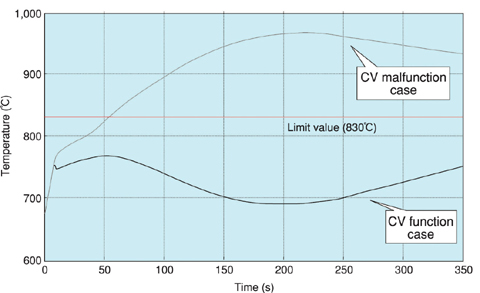Fig.1-22 1loop PHTS pump trip event

Fig.1-23 Fuel cladding temperature in 1loop PHTS pump trip without scram
Fig.1-24 1loop PHTS pump trip sequence event tree
Safety of a nuclear power plant has been improved with reliable measures for the following three stages: prevention of abnormal event occurrence, the suppression of abnormal event expansion, and the reduction of radioactive material release.
The probabilistic analysis approach is effective to evaluate these improved reliability of safety measures whose failure probabilities are very small.
As one specific probabilistic safety assessment of "MONJU", the frequency of Anticipated Transient without Scram (ATWS) was evaluated.
Fig.1-22 shows one ATWS event where a pump trip event in one loop of the primary heat transport system (PHTS) is explained. The B loop PHTS of three cooling loops in "MONJU" has its pump tripped. It is shown that the core coolant flow is secured if the check valve of the tripped loop closes, by hydraulic effect from the intact loops. The PHTS pump trip in this loop generates a reactor trip signal; however, reactor trip failure is supposed in this case. We also suppose the failure of the check valve closure in this evaluation.
As shown in Fig.1-23, fuel cladding temperature behaviors were analyzed in the PHTS pump trip of one loop without scram. As analytical result, in the case with the check valve functioning, the maximum cladding temperature was below the temperature limit for reactor core intactness.
All of event sequences in the sequence event tree analysis shown in Fig.1-24 were evaluated. The first branch divides according to whether the reactor trip signal is generated by the one loop PHTS pump trip successfully or not. If the reactor trip signal was generated, the next branching in this sequence centers on control rod insertion failure. If the reactor trip signal generation failed, the next branching in this sequence centers on check valve closure. The failure probabilities of these safety features are analyzed by the system fault tree. These probabilities are estimated as 10 -10 - 10-5 per demand, and thus these safety features function reliably.
The total ATWS frequency of "MONJU" is estimated as 10 -8 per reactor year. These studies indicate that the ATWS frequency of "MONJU" is sufficiently small and thus that the safety functions have high reliability.